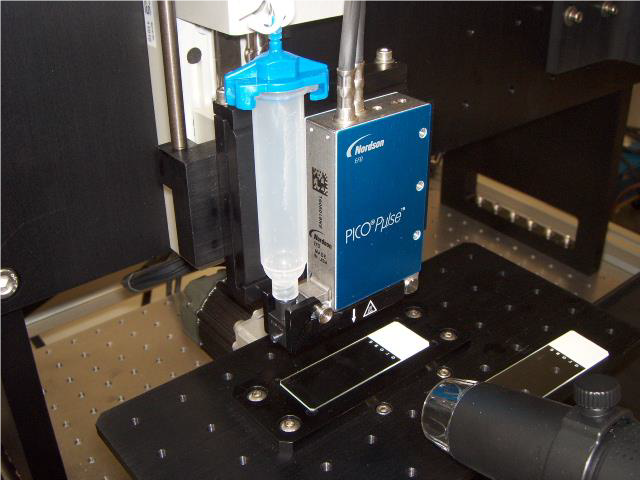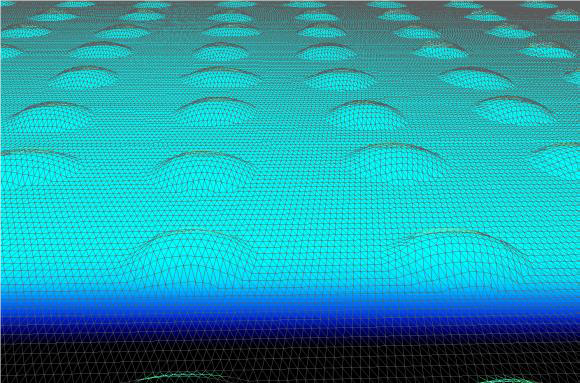Automating precision solutions that overcome complex challenges and consistently meet demanding production goals is no small feat. When that solution requires a complex dispensing application, the task becomes exponentially more challenging. Using a first principles approach, DWFritz’s team of engineers excel at developing precision dispense applications.
Taking care to fully capture each clients’ specific requirements, we execute a rigorous process of assessment, planning, design, and execution to fit the right solution to the problem. In some cases, we can integrate a best-in-class dispense technology from a technology partner into a custom solution, but to overcome the most vexing challenges and meet the toughest application requirements, we often use several methods to design and build innovative dispensing solutions for complex applications.
Technology Validation via Risk Mitigation
DWFritz provides a deep bench of engineering knowledge and project management expertise to reduce program risk throughout the development cycle. We ensure that proposed technical solutions are both reasonable and feasible with elimination of technical risk and uncertainty being our highest single priority.
We work both internally and with 3rd party equipment vendors to perform proof-of-principle (PoP) or proof-of-concept (PoC) work directly for your specific application during the concept and initiation phases of a project. These steps ensure that we select or design a dispense technology that will meet the customer’s needs and reduce lead-time or investment risk during the project.

In-house PoP and performance benchmarking of a Nordson commercial dispense solution on a DWFritz test bed machine.
Ensuring Design for Manufacturing (DFM) Methodology
As product designers and product manufacturing engineers proceed through the design lifecycle of a product, automation is typically one of the last, and lowest priority, considerations of the design. By accounting for, and closely collaborating with, an automation partner to co-develop the manufacturing strategy of a product, significant cost reductions – of both the product and custom manufacturing equipment – can be realized.
For example, on an energy system storage device, the customer wanted to ensure an even and consistent bond joint between an individual battery cell and a cooling system. By using a simple thermal interface material (TIM) when assembled and compressed for cure, all the adhesive would be squished out of the bond, leaving insufficient epoxy behind. To overcome this issue and solve our customer’s problem, DWFritz suggested adding glass media to the epoxy of a controlled diameter, which resulted in a consistent and evenly distributed support that sets the bond joint gap precisely at the design target without the addition of expensive alignment features or fixturing.
Holistic Systems Approach
Dispensing technology is only one component of developing a high-performing dispense application for production readiness. The process of automation and integration has to consider all aspects of the system as a whole – pairing the correct hardware and custom software to create the performance and reliability needed for today’s most demanding assembly applications.
Needle Wiping and Cleaning
One of the most crucial factors to ensuring the success of high-precision dispensing is needle tip cleanliness. Adhesive buildup on a dispense tip can cause clogs, poor bead formation, part damage, excess glue in unintended areas, poor ability to locate a tip, and a myriad of other technical challenges. Beyond the technical risk, buildup can lead to loss of availability and throughput, along with increased operation costs as a machine operator must shut down the system to wipe or clean the dispense tip.
For a recent medical device dispense and assembly application, the customer requested a high equipment OEE (Overall Equipment Effectiveness) with world-class system availability. During our risk assessment, we identified needle cleaning as a significant loss of productivity, with an estimated three to four operational interventions per hour that was required. To alleviate this issue, we integrated a commercially available wiping system into the machine, and our team of application engineers developed a custom machine vision tool that checks the needle for excess epoxy after every single part processed. If any excess epoxy is detected out of spec, the needle is sent through a fully autonomous wiping and priming sequence. This automation saves up to 5 minutes per hour of runtime, increasing the ROI of our equipment by up to 8%.
Dispense Tip Temperature Control
Fluid viscosity can change dramatically with relatively small ambient temperature swings. One method of increasing process stability is via in-process heating (or chilling for exothermic epoxies) to ensure consistent temperature at the nozzle.
DWFritz puts this under machine control with thermocouple feedback and software driven setpoints, ensuring that, regardless of ambient or seasonal temperature swings, the process is unaffected. This has a dramatic effect on overall system performance with 2K (2 part) structural bonding applications in the consumer electronics wearable and handheld industries.
Adhesive Mass Accuracy
To ensure the highest level of process reliability and stability, we integrate highly accurate precision analytical balances into automated dispensing tools. This enables fully automating taring and in-process checks for shot weight in electronic assembly or energy system potting systems. Using this configuration, our custom software can deterministically correct for minor changes in adhesive density or other process variables without operator intervention.
Part Motion and Active Alignment
In a recent medical device dispense and assembly operation, the customer parts required a very small amount of adhesive (~50nL) applied circumferentially around a ~1.5mm diameter. In order to lay down this miniscule bead of glue, we had to precisely account for and mitigate part-to-part variation and pick head variation, which created a tolerance stackup higher than the height of the bead itself. By creating an integrated system using metrology-class machine vision, custom lighting, and a high-precision multi-axis servo system with our custom software at the helm, we could actively align every single part to ensure that part runout during dispense is kept to less than 25um (0.001″), enabling a consistent bead and volume to be applied to every part.

Using non-contact 3D metrology for volume measurement of nanoliter scale adhesive droplets. Center to center pitch of 1.5mm for scale.
Curing and Cure Fixturing
Putting the right amount of adhesive in the right location is only one part of ensuring success in automated precision dispense. The cure cycle of the parts and how they are constrained during cure can be just as important. Many adhesives can expand, shrink, or warp during cure, which may distort the assembly. Our deep expertise with high-precision part work holding, tooling, and fixtures allows us to create a complete solution around all aspects of a dispense application.
We implement automated inline cure buffers and cure oven systems – creating automated material handling solutions to transport cure fixtures through an oven, or storing a wet part into a buffer location for a fixed duration to allow it to cure. Integration of the curing process into an automated line or system allows software enforcement of cure requirements for time and/or temperature. DWFritz has provided solutions in the medical device, consumer electronics, and energy storage industries to fixture, cure, and automatically de-fixture parts following automated precision dispense.
From concept to delivery, DWFritz commits to developing the best possible solution to our clients’ automation challenges. Drawing on our expertise across a broad range of technologies, we routinely develop automation systems with dispensing speeds of 150 milliseconds per placement and 20-micron repeatability. Whatever your complex dispense challenge, DWFritz is your precision automation partner.
